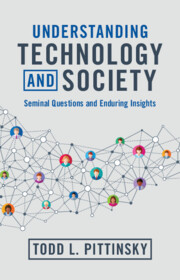Refine search
Actions for selected content:
680 results
1 - Nature and Sources of Labour Law
- from Part I - Introduction
-
- Book:
- Labour Law
- Published online:
- 02 October 2025
- Print publication:
- 20 November 2025, pp 3-45
-
- Chapter
- Export citation
8 - Just Don’t Get Caught!
- from Introduction to Part I
-
-
- Book:
- Human Rights in the Digital Domain
- Published online:
- 24 October 2025
- Print publication:
- 13 November 2025, pp 138-150
-
- Chapter
-
- You have access
- Open access
- HTML
- Export citation
4 - Regulatory Design, Trust, and Voluntary Compliance
-
- Book:
- Can the Public be Trusted?
- Published online:
- 11 October 2025
- Print publication:
- 30 October 2025, pp 92-120
-
- Chapter
-
- You have access
- Open access
- HTML
- Export citation

Human Rights in the Digital Domain
- Core Questions
-
- Published online:
- 24 October 2025
- Print publication:
- 13 November 2025
-
- Book
-
- You have access
- Open access
- Export citation
13 - Inframarginalism and Economism
-
-
- Book:
- Toward an Inframarginal Revolution
- Published online:
- 26 September 2025
- Print publication:
- 16 October 2025, pp 468-491
-
- Chapter
- Export citation

Can the Public be Trusted?
- On the Promise and Perils of Voluntary Compliance
-
- Published online:
- 11 October 2025
- Print publication:
- 30 October 2025
-
- Book
-
- You have access
- Open access
- Export citation
11 - Drawing from AMR Experience for Better Prevention, Preparedness, and Response to Complex Health Threats under a One Health Approach
- from Part II - One Health and Contemporary Legal Structures
-
-
- Book:
- The Cambridge Handbook of One Health and the Law
- Published online:
- 25 September 2025
- Print publication:
- 09 October 2025, pp 157-180
-
- Chapter
- Export citation
6 - Regulatory Intervention
-
- Book:
- Regulating a Thousand Cuts
- Published online:
- 27 September 2025
- Print publication:
- 09 October 2025, pp 130-176
-
- Chapter
-
- You have access
- Open access
- HTML
- Export citation
11 - Design for Regulating a Thousand Cuts
-
- Book:
- Regulating a Thousand Cuts
- Published online:
- 27 September 2025
- Print publication:
- 09 October 2025, pp 310-330
-
- Chapter
-
- You have access
- Open access
- HTML
- Export citation
Chapter 30 - Emotion and Affective Disorders
- from Section VII - Individual Differences
-
-
- Book:
- The Cambridge Handbook of Human Affective Neuroscience
- Published online:
- 16 September 2025
- Print publication:
- 02 October 2025, pp 604-617
-
- Chapter
- Export citation
Chapter 26 - Neural Evidence for Cultural Variation in Emotion
- from Section VI - Social Emotions
-
-
- Book:
- The Cambridge Handbook of Human Affective Neuroscience
- Published online:
- 16 September 2025
- Print publication:
- 02 October 2025, pp 523-543
-
- Chapter
- Export citation
Chapter 18 - Episodic Emotional Memory
- from Section IV - Emotional Learning and Memory
-
-
- Book:
- The Cambridge Handbook of Human Affective Neuroscience
- Published online:
- 16 September 2025
- Print publication:
- 02 October 2025, pp 363-382
-
- Chapter
- Export citation

Understanding Technology and Society
- Seminal Questions and Enduring Insights
-
- Published online:
- 30 September 2025
- Print publication:
- 10 July 2025
Chapter 9 - Corporate fundraising
-
- Book:
- Contemporary Australian Corporate Law
- Published online:
- 11 September 2025
- Print publication:
- 25 September 2025, pp 277-306
-
- Chapter
- Export citation
Chapter 18 - Financial services
-
- Book:
- Contemporary Australian Corporate Law
- Published online:
- 11 September 2025
- Print publication:
- 25 September 2025, pp 631-654
-
- Chapter
- Export citation
Chapter 1 - Context, history and regulation
-
- Book:
- Contemporary Australian Corporate Law
- Published online:
- 11 September 2025
- Print publication:
- 25 September 2025, pp 1-51
-
- Chapter
- Export citation
12 - Clinical governance
- from Part 3 - Engages Others
-
-
- Book:
- Leading and Managing Health Services
- Published online:
- 15 August 2025
- Print publication:
- 28 August 2025, pp 131-141
-
- Chapter
- Export citation
Assessing the engineering design costs to meet environmental regulations: the case of packaging
-
- Journal:
- Proceedings of the Design Society / Volume 5 / August 2025
- Published online by Cambridge University Press:
- 27 August 2025, pp. 661-670
-
- Article
-
- You have access
- Open access
- HTML
- Export citation
9 - Conclusion
-
- Book:
- Extroverted Financialisation
- Published online:
- 07 August 2025
- Print publication:
- 21 August 2025, pp 162-174
-
- Chapter
- Export citation
2 - Legal and Contractual Aspects of Agency and Player–Agent Relations in Professional Tennis
- from Part 1 - Contractual
-
-
- Book:
- Professional Tennis and Transnational Law
- Published online:
- 07 August 2025
- Print publication:
- 21 August 2025, pp 23-41
-
- Chapter
-
- You have access
- Open access
- HTML
- Export citation
